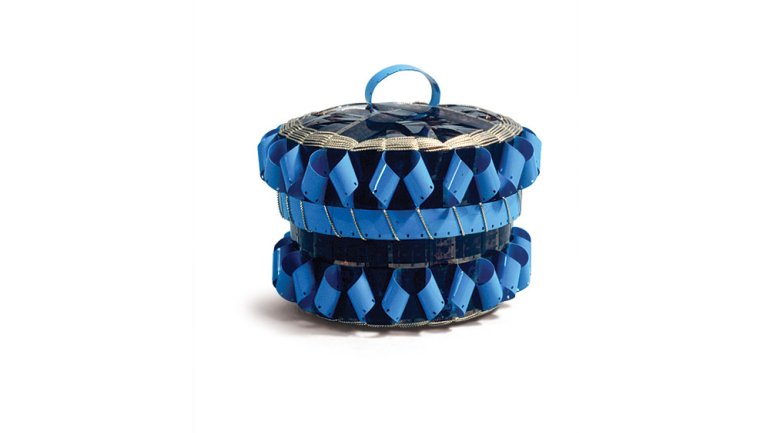Reweaving History
Reweaving History
Nowhere has the stereotype of indigenous Americans as barbarian been as poisonous as in film images from the first half of the 20th century. But Gail Tremblay has an antidote. Steeped in traditional basketry techniques she learned from her aunts, the Onondaga and Mi’kmaq writer and mixed-media artist references cinematic narratives in her basket works, challenging those tropes with an alternative storyline.
Tremblay began combining two seemingly discordant art forms while co-teaching a Third World and feminist film theory class in 1985 at the Evergreen State College, in Olympia, Washington, where she still teaches. “I loved film as a material,” she says. “I liked the recycling aspect of it.”
Tremblay uses green, blue, yellow, and often red film leader – the length of film attached to the end of a filmstrip to make threading it through a projector easier. She has acquired much of her material from libraries that have emptied their film collections in favor of DVDs.
Her work is in permanent collections across the United States, including at the Museum of Arts and Design, which acquired It Was Never About Playing Cowboys and Indians (2011). The piece borrows imagery from a 1975 documentary, Play and Cultural Continuity, Part VI: Montana Indian Children, which explores the importance of play to the cultural identity of indigenous children. Originally part of a 2012 MAD exhibition, the basket incorporates original 16-millimeter footage of children doing beadwork and placing dolls in cradle boards. The depiction of indigenous culture contrasts sharply with classic shoot-’em-up American games like cowboys and Indians. Cultural customs rather than weapons and aggression take the spotlight.
Using a red and blue porcupine point stitch to reference “the prickly nature of Indian-white relations in America,” Tremblay also weaves in lines of white leader to highlight choice scenes. “I choose images and films deliberately, even if you can’t see them. It might not be the first thing you notice – you have to look closely. But the images are important; they tell a story.”
Tremblay’s work can be hard-hitting. And Then There Is the Hollywood Indian Princess (2002) mixes red leader, dark images, and pale yellow film to suggest the much-frowned-upon union of “red” woman with white man. “There’s no shortage of early 20th-century film in which the female Indian is forced to die a tragic death at the end, suggesting to viewers that such unions always end badly,” Tremblay says. Where did she lift her images? From an educational film on sexually transmitted infections.
It’s a telling detail and shows how Tremblay, by joining two art forms that seemingly have little common ground, unabashedly illuminates pernicious stereotypes with sparkling clarity.
A solo exhibition of Gail Tremblay’s baskets will be on display at Froelick Gallery in Portland, Oregon, in May.
Suzanne Beal is a writer in Seattle.




